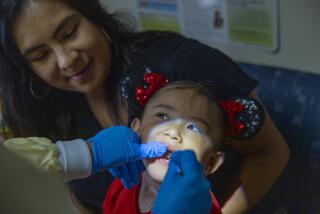Virtual Techniques Improving Dental Reality
- Share via
With two upper teeth conspicuously missing, 13-year-old Oscar Ruiz Jr.’s smile looked like that of a much younger child.
His parents couldn’t figure out why the canine teeth hadn’t come in, and although Oscar wasn’t in pain, dentist after dentist said the adult teeth needed to descend since they were damaging the adjacent ones.
But they all refused to take his complex case, and the Ruiz family came to USC’s dental school simply hoping to find someone who would agree to treat him.
There, Oscar became an early beneficiary of a computer program that creates animated 3-D images of patients’ heads and necks, accurate down to the person’s jaw movements and tooth decay.
The Virtual Craniofacial Patient Laboratory, one of a handful in the country so advanced, helped surgeons plot the recent surgery to expose the teeth with fewer and more accurate incisions than working from X-rays. Computer-based planning also helped the Ruiz family understand where Oscar’s teeth were and how doctors would attach spring-equipped braces that will drag them into place over the next two years.
“None of the other dentists’ explanations made sense,” said Oscar Ruiz Sr., 34, of Norwalk. “All we could see was gum when we looked in his mouth, and we couldn’t understand why.”
The laboratory, developed a couple of years ago, is a partnership between USC’s dentistry and medical schools and the engineering schools at USC and UCLA.
A virtual patient profile enables surgeons to explore different treatments and more accurately predict results, researchers said.
“Most of the time doctors’ explanations consist of a lot of verbal descriptions and hand-waving,” said Dr. James Mah, head of the USC laboratory. “With this program, we can take what’s going on inside our heads and show it to patients.”
During a recent postoperative checkup, Oscar slumped in a chair and alternately toyed with his braces and with a Discman holding a Korn CD, uninterested in the 3-D image of his teeth gliding across a monitor.
But as research associate Reyes Enciso used a mouse to erase Oscar’s lower teeth and focus on the glowing green canines hovering above the rest, his father’s mouth dropped open as his eyes followed the floating teeth.
“It’s amazing,” he said, his voice trailing off as he watched.
Most dentists and craniofacial surgeons rely on photographs, X-rays and stone models to develop treatments. The best images that those tools can create resemble yellow clouds with fuzzy red edges instead of an exact jawline.
But with virtual patient technology, a very accurate likeness is created with four tools: a normal computer using a jaw motion tracker, a 3-D dental camera that takes pictures inside the mouth, a CT scanner to create X-ray-type photos and images of a plaster model to capture the shape of the external flesh.
At USC, the new technology has helped surgeons implant an artificial ear into a freckled toddler born with only a bud on the right side of his head and realign the mouth of a man whose teeth had haphazardly contorted to fit his crooked jaw.
“There aren’t an infinite number of surgeons who can do this kind of work,” Mah said. “Now instead of mentally reconstructing the past when they try to explain how to do these procedures, they can send someone a CD-ROM with the surgery on it in 3-D.”
Starting this fall, the program will be used to make braces for those in areas around California with no orthodontists.
Visiting technicians equipped with the necessary tools will send images of the patients’ mouths to USC.
There a machine resembling a knee-high R2D2 swallows lengths of straight wire and spits out braces, shaped more accurately than an orthodontist can by hand. Brackets and glue are added at the dental school before the braces are shipped to patients’ dentists.
Such computer programs are a sort of flight simulator for medical and dental students, said researchers at the National Biocomputation Center, a joint project between Stanford and NASA where doctors have been developing similar technology for the last eight years.
“Rather than training on the patients who walk through the door today, they can train on every patient who has ever walked through the door,” said the center’s technical director, Kevin Montgomery. “And all these benefits come without risk to real patients.”
An American Dental Assn. official said virtual patient technology is an efficient supplement to classroom materials.
“Human material is expensive, and once you’ve dissected it, it’s gone,” said Dr. Laura Neumann, associate executive director of education.
Within a year, the addition of virtual touch to the technology will allow USC medical and dental students to put on gloves and feel the texture and resistance of slicing through skin and bone on various types of surgeries before performing them on actual patients.
“I think patients always prefer someone who’s proficient at something rather than one who’s just seen some pictures or poked around on a couple of people,” Neumann said. “Virtual teaching creates more confident dentists.”
Oscar’s father said the computer procedure’s $350 price tag was well worth it.
“It not only helped the doctors, but it helped me be sure this was the right thing to do for my son,” Ruiz said. “That peace of mind is pretty valuable.”






